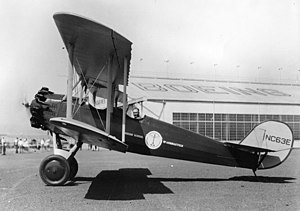| Model 81 / XN2B | |
|---|---|

| |
| Role | trainer |
| National origin | United States |
| Manufacturer | Boeing |
| Introduction | 1928 |
| Primary user | Boeing School |
| Number built | 2 |
| Developed from | Boeing Model 64 |

The Boeing Model 81 was an American training aircraft built by Boeing in 1928. The Model 81 was a development of the Model 64. It was powered by a newly developed engine, the 125 hp Fairchild-Caminez 4-cylinder radial engine.[1] Operating at a much lower rpm than most engines (1000 rpm) it required the use of a large high-pitch propeller.[2]
After initial flight tests with the Fairchild-Caminez, the prototype was refitted with a 145 hp Axelson engine, redesignated Model 81A and delivered to the Boeing School of Aeronautics. There, it was re-engined a number of times, first with a 115 hp Axelson engine, redesignated Model 81B. It then received a 165 hp Wright J-6-5, then a 100 hp Kinner K-5 and a redesigned vertical tail. Redesignated Model 81C, it would later be removed from training service, re-engined with an Axelson engine, and used as a classroom trainer.[3]
On 21 June 1928, the second Model 81 built was delivered to the US Navy at Anacostia, Maryland for $8,300, and redesignated Boeing XN2B. Its trial with the Fairchild engine was unsatisfactory, and on 10 January 1929 it was refitted by Wright Aeronautical with a 160 hp Wright J-6-5 engine. Despite increased performance, it was not ordered into production.[4]
- ^ "A diagram of the 4-cylinder Fairchild-Caminez cam engine". Archived from the original on 2017-10-05. Retrieved 2011-11-12.
- ^ Bowers, 1989, p. 142
- ^ Bowers, 1989, pp. 144-145
- ^ Bowers, 1989, pp. 142-144